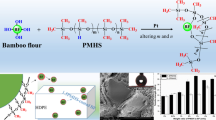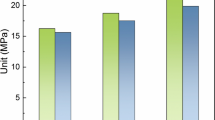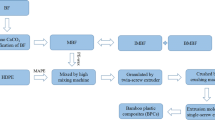Abstract
The influence of flake graphite (FG) content on the mechanical properties, triboelectrification electrostatic potential, and electrical resistivity of the bamboo flour (BF)/high-density polyethylene (HDPE) composites was investigated. The morphology of the fracture surfaces of the composites was analyzed using scanning electron microscopy. When FG was added to the BF/HDPE composites, the composites were readily deformed or damaged under the external load because of stress concentration and slippage of the interfacial layer in the BF/HDPE composites. The electrical resistivity of the BF/HDPE composites reached an anti-triboelectrification threshold because of the formation of conductive paths. However, when the FG mass fraction was less than the anti-triboelectrification threshold, the triboelectrification electrostatic potential of the BF/HDPE composites reduced in the order oxygen > nitrogen > air > argon > vacuum because the ionization or activation of the gas molecules contributed to the improvement of the triboelectrification electrostatic potential of the BF/HDPE composites.





Similar content being viewed by others
References
Ashori A (2008) Wood-plastic composites as promising green-composites for automotive industries. Bioresour Technol 99:4661–4667
Aurrekoetxea J, Sarrionandia M, Gómez X (2012) Effects of microstructure on wear behaviour of wood reinforced polypropylene composite. Wear 265:606–611
Aydemir D, Kiziltas A, Kiziltas EE, Gardner DJ, Gunduz G (2015) Heat treated wood-nylon 6 composites. Compos Part B Eng 68:414–423
Bai G, Li LP (2014) Preparation and property of flame retardant and anti-static wood flour-polypropylene composites. J Beijing For Univ 36:136–141
Binhussain MA, El-Tonsy MM (2013) Palm leave and plastic waste wood composite for out-door structures. Constr Build Mater 47:1431–1435
Crowley JM (1990) The electrostatics of static-dissipative worksurfaces. J Electrostat 24:221–237
Deng QY, Li DG, Wu ZY, Ding JS (2012) Effect of hot water on the dimensions and abrasion resistance of HDPE/rice hull WPC. China Plast Ind 40:104–107
Fang YQ, Wang QW, Guo CG, Song YM, Cooper PA (2013) Effect of zinc borate and wood flour on thermal degradation and fire retardancy of Polyvinyl chloride (PVC) composites. J Anal Appl Pyrol 100:230–236
Ghori MU, Šupuk E, Conway BR (2014) Tribo-electric charging and adhesion of cellulose ethers and their mixtures with flurbiprofen. Eur J Pharm Sci 65:1–8
Hančič A, Kosel F, Kuzman K, Slabe MJ (2012) Comparison of two micromechanical models for predicting elasto-plastic response of wood-plastic composites. Compos Part B Eng 43:1500–1507
Hiratsuka K, Kazumasa K (2012) Effects of friction type and humidity on triboelectrification and triboluminescence among eight kinds of polymers. Tribol Int 55:87–99
Hung KC, Chen YL, Wu JH (2012) Natural weathering properties of acetylated bamboo plastic composites. Polym Degrad Stab 97:1680–1685
Jeamtrakull S, Kositchaiyong A, Markpin T, Rosarpitak V, Sombatsompop N (2012) Effects of wood constituents and content, and glass fiber reinforcement on wear behavior of wood/PVC composites. Compos Part B Eng 43:2721–2729
Kaymakci A, Ayrilmis N (2014) Investigation of correlation between Brinell hardness and tensile strength of wood plastic composites. Compos Part B Eng 58:582–585
Leu SY, Yang TH, Lo SF, Yang TH (2012) Optimized material composition to improve the physical and mechanical properties of extruded wood-plastic composites (WPCs). Constr Build Mater 29:120–127
Li JH, Li M, Da HF, Liu Q, Liu MH (2012) Preparation of Nylon-6/flake graphite derivatives composites with antistatic property and thermal stability. Compos Part A Appl S 43:1038–1043
Li YW, Wang QH, Fan HB, Sang SB, Li YB, Zhao L (2014) Synthesis of silicon carbide whiskers using reactive graphite as template. Ce-ram Int 40:1481–1488
Merkel K, Rydarowski H, Kazimierczak J, Bloda A (2014) Processing and characterization of reinforced polyethylene composites made with lignocellulosic fibres isolated from waste plant biomass such as hemp. Compos Part B Eng 67:138–144
Muniyandi SK, Sohaili J, Hassan A (2013) Mechanical, thermal, morphological and leaching properties of nonmetallic printed circuit board waste in recycled HDPE composites. J Clean Prod 57:327–334
Najafi SK (2013) Use of recycled plastics in wood plastic composites—a review. Waste Manage 33:1898–1905
Nie HK, Liu F, Xu DM, Liu QQ, Xu J, Cheng AY (2011) Properties of WPC based on PP filled and modified by eggshell powder. Eng Plast Appl 39:21–23
Ning LP, Jian LQ, Yang SR, Wang JQ, Ren JF, Wang JM (2010) Effect of carbon black on triboelectrification electrostatic potential of MC nylon composites. Tribol Int 43:568–576
Ortiz AV, Teixeira JG, Gomes MG, Oliveira RR, Díaz FRV, Moura EAB (2014) Preparation and characterization of electron-beam treated HDPE composites reinforced with rice husk ash and Brazilian clay. Appl Surf Sci 310:331–335
Prasad AVR, Rao KM (2011) Mechanical properties of natural fibre reinforced polyester composites: Jowar, sisal and bamboo. Mater Design 32:4658–4663
Sun XQ, Li QY, Huang PP, Zheng YC (2010) The influence of filler on bending property of wood-plastic composite. J Qingdao Technol Univ 31:28–31
Wang JL, Yang WQ, Lei JX (2008) A novel method to prepare polymer electrolyte based on thermoplastic polyurethane and its antistatic composites. J Electrostat 66:627–629
Wang Y, Zhang C, Du ZJ, Li HQ, Zou W (2013) Synthesis of silver nanoparticles decorated MWCNTs and their application in antistatic polyetherimide matrix nanocomposite. Synth Metals 182:49–55
Wegst UGK (2011) Bending efficiency through property gradients in bamboo, palm, and wood-based composites. J Mech Behav Biomed 4:744–755
Yeh SK, Agarwal S, Guptaa RK (2009) Wood-plastic composites formulated with virgin and recycled ABS. Compos Sci Technol 69:2225–2230
Zhang ML, Wang QW, Fang YQ (2010) Anti-electrostatic wood flour/Polyvinyl chloride composites. J Northeast For Univ 38:61–63
Zhou YW, Ning LP, Wang YG, Xie DH, Wu S, Wang J (2014a) Effect of xylanase solution on material properties of betula alnoides/HDPE wood plastic composites. Acta Mater Compos Sin 31:338–344
Zhou C, Ji G, Chen Z, Wang ML, Addad A, Schryvers D, Wang HW (2014b) Fabrication, interface characterization and modeling of oriented graphite flakes/Si/Al composites for thermal management applications. Mater Design 63:719–728
Acknowledgments
This research was funded by the Education Department of Sichuan Province of the People’s Republic of China, Project No. 10ZA042. The authors would especially like to thank Prof. Liping Ning from the Key Laboratory of Wood Industry and Furniture Engineering of Sichuan Agricultural University for her continued support for the research project.
Author information
Authors and Affiliations
Corresponding author
Rights and permissions
About this article
Cite this article
Zhou, Y., Ning, L., Li, X. et al. Effect of natural flake graphite on triboelectrification electrostatic potential of bamboo flour/high-density polyethylene composites. Wood Sci Technol 49, 1269–1280 (2015). https://doi.org/10.1007/s00226-015-0752-6
Received:
Published:
Issue Date:
DOI: https://doi.org/10.1007/s00226-015-0752-6




